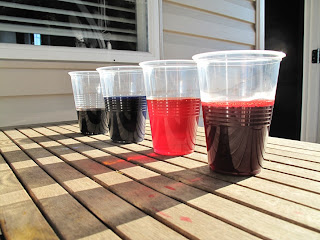From left to right, we have Jacquard acid dye in Chestnut, then Ciba colours Cobalt, Golden Yellow and Red.
When you look at them from above, the sun casts a shadow with a highlight that shows the colour:
(in this one they're sorted red, yellow, blue, brown)
Here's what I did:
- I got out every piece of dyeing equipment I own and took it to the back deck. Include in your mental image a pair of black nitrile gloves (sweaty hands inside those gloves on this delightful summer day), a particulate mask, a container of Culligan water (trying to avoid chlorine and whatnot in the tap water, although I'm not sure that's really important. I had the water kicking around, so I used it), a stainless steel pot and two kitchen scales (I like to check one against the other ... call me OCD. Actually, I'm not OCD - I'm CDO. The letters should be in alphabetical order, for heaven's sake!)
- I measured 500mL of water (8oz = 250mL for those who are confused by my metric brain) and put it in the pot.
- I measured 15g of chestnut dye powder (that was the whole container, which claimed it was a half-ounce) and put it in the pot.
- I measured 1 drop of Synthrapol into the pot.
- I turned the heat on, got it steaming, and stirred it until the dye was dissolved.
- I poured it into a container that holds a litre (1000mL = 1L ... you do the non-metric math) and added another 500mL of water.
- I poured that into the glass jar that I'm going to store it in for up to six months. I had a little bit extra, so that went into the plastic cup. I'll use that for sampling tomorrow (stay tuned for that ridiculously exciting post).
Weight of fibre. If I know what the fibre weighs dry, I'll know how much total dyestock to use to get a 2% depth of shade, which is what I think I need to get a rich brown. I'm working with 1100g of fibre, so I'll split that and work with an even 1000g and then whatever that calculation yields, I'll add a tenth of it to make up for the extra 100g of fibre. (Yes, it would have been much easier to do this math had I used 10g of dye powder instead of 15g, but it's still a multiple of 5 and therefore not a weird or tricky number.) Each skein of undyed yarn is 100g, so when I go to do the immersion dyeing, I'll divide my total dyestock number by 11 and make sure I use that much for each skein as it goes in the pot.
I also have to figure out, since my sampling is going to be done on a very small scale, how to take the ratio that I find for the perfect blend of chestnut, cobalt, red and yellow and scale it up to the total amount of dyestock required for the fibre. For example, if I use 2 drops of chestnut and one each for the others, that's 2:1:1:1. I can then use that in my master calculation for the 1000g + 100g of fibre.
I'm off to do some math. And eat local, fresh raspberries and peas. I couldn't resist, even though the price they charge for raspberries comes close to highway robbery. (I bought them at a place close to the side of the highway, so it's not regular robbery - it's highway robbery.)
Shut up, spellcheck - fibre, litre and colour are spelled correctly!



Wow I'm impressed.
ReplyDelete